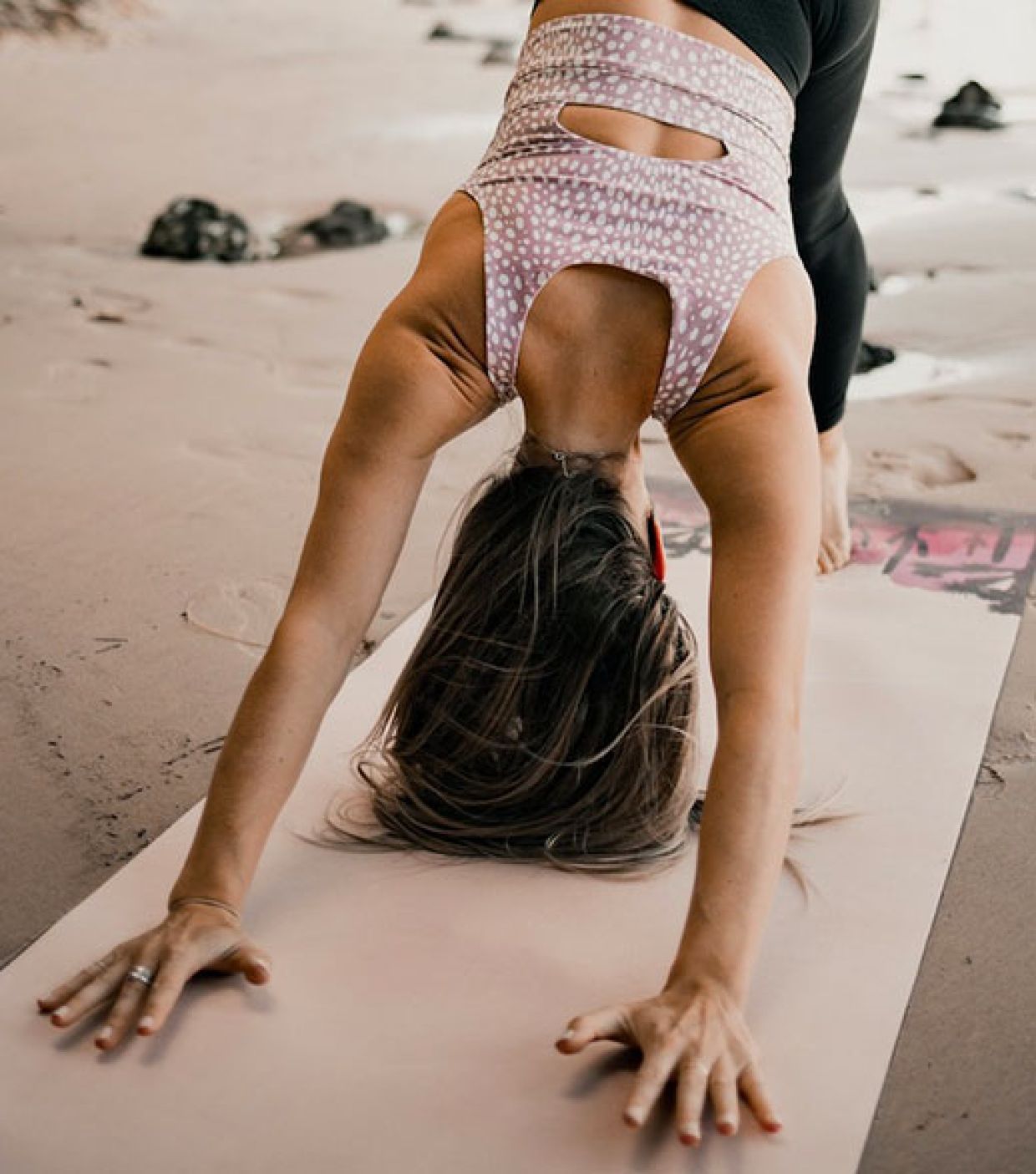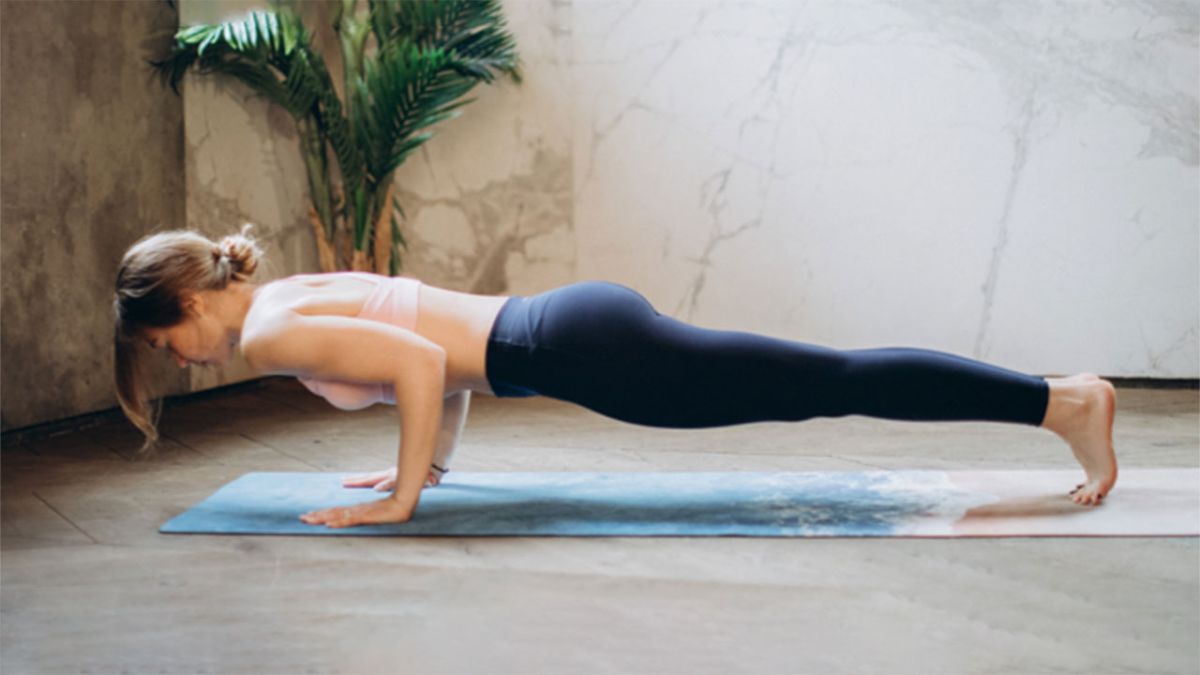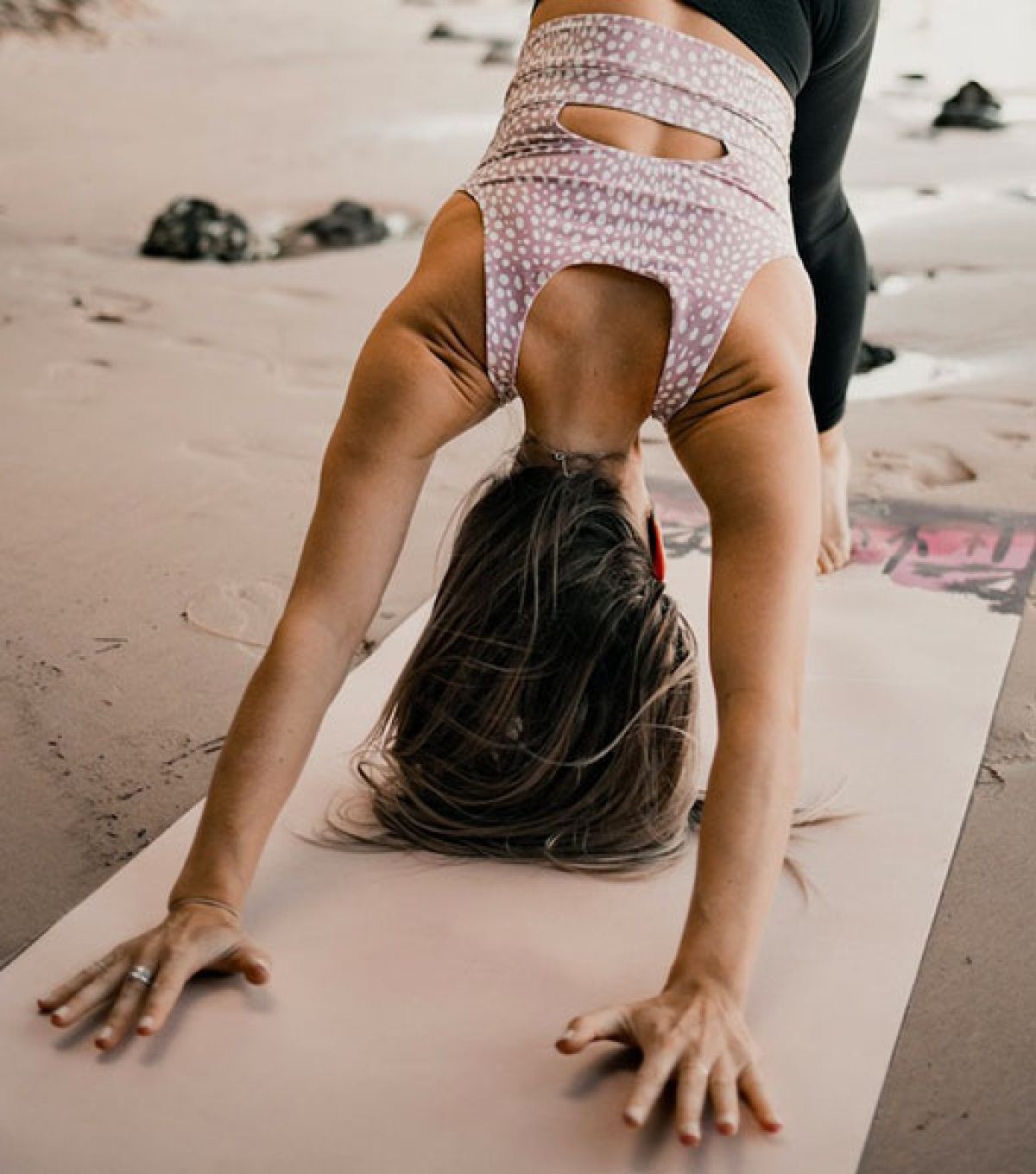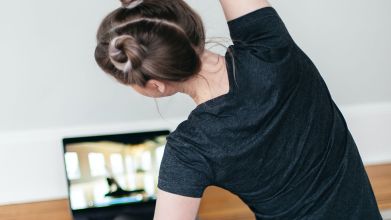

Classical Mat Sequence

Begin your exploration in Pilates with an integral part of the original Pilates method, matwork. Mat sequences can be completed anywhere you can find the space to move and protection for your spine including a mat, towel, or even a mattress when traveling and on the go. The classical mat sequence will provide you with a tremendous amount of strength, mobility, improved circulation, and body awareness, while helping prevent injury, reduce chronic pain, correct posture, and create a greater sense of confidence. Here is a step-by-step tutorial of our classical mat sequence that you can start with on your Pilates journey.
The Hundred
Begin The Hundred on your back with one long breath in followed by one long breath out. Next, anchor your center from navel to spine, keeping the inside of your legs together to feel strength in your inner thighs and bum.
A good starting point for this exercise is three to five sets, increasing to ten as your strength builds. If you begin to experience fatigue in your neck, feel free to drop it. Your neck will strengthen as you progress over time.
The Roll Up
Carefully maintain the anchor at your center as you roll up and down from your back one vertebrae at a time, engaging the inner and rear portions of your thighs and bum by keeping your legs glued to the mat.
Be certain to keep your shoulders relaxed and away from your ears and be cautious of reaching too far forward at the end of your movement.
The Roll Over
Lying on your back with your arms by your sides and your palms down, extend your legs up towards the ceiling while tilting your pelvis backwards. Reach your legs up and over your head, keeping your feet parallel to the ground. Maintain control and avoid throwing your legs over your head in this exercise.
The One Leg Circle
Positioned on your back, reach your working leg over your body in a circular, flowing motion as your other leg remains centered and stretched out firmly on the mat. It is particularly important to remember this flowing motion on the upswing while being cautious not to tense your foot as you reach towards the ceiling.
Begin with the first variation, allowing your hips to roll. In a second variation, settle your hips and find stillness with the mat.
Rolling Back
Roll backwards using your powerhouse to create balance and control through a smooth, flowing movement. Your heels should remain close to your bum, preventing the motion from being initiated from your legs. It is important to keep your head in the same position throughout the movement.
The One Leg Stretch
In the One Leg Stretch, lie on your back with your knees to your chest, extending one leg out at a time in a diagonal and keeping your hips, knees, and feet aligned. Imagine a weight in your stomach keeping your abdominals in as you progress through the movement. As you become stronger, skim your bottom foot along the mat to lengthen your leg.
The Double Leg Stretch
Remaining flat to the mat on your back with your knees to your chest, extend your arms by your ears while simultaneously extending your legs forward. Keep your head in the same position throughout this movement and engage your powerhouse without straining to hold the position. Lower your legs further to increase work, but be sure to keep them at or above eye level.
The Spine Stretch
Sitting tall with your legs extended, knees facing the ceiling, hips glued to the mat, and feet flexed, smoothly curl your body forward. Stretch your back further each time while engaging your powerhouse and relaxing your shoulders away from your ears. Form a curve in your back as you stretch by keeping your eyes on your navel throughout the movement.
Rocker with Open Legs
Visualizing that your arms and legs are as straight as arrows and maintaining control and balance, rock back and forth coordinating your rhythm with your breath and the strength of your powerhouse. Balance momentarily as you rock up to the seated position and avoid throwing your head backwards.
Substitute the rock for a seated position, extending one leg at a time as wide as your shoulders for a modified version.
The Corkscrew
Starting on your back and keeping your belly scooped in, use abdominal control to take your legs to the side while keeping them together. Circle your legs down through a low center with your upper body remaining stable and your lower back remaining on the mat.
The Saw
Beginning in the spine stretch position with a relaxed neck, twist and reach your arms one at a time to your opposite foot, initiating the movement from your waist. Lengthen your arms and empty your lungs, leaving your bum on the mat. Keep your head in line with your little toe with each movement.
The Swan-Dive
Lying on your stomach with your legs together and your hands placed by your head, lift your abdominals away from the floor while sending your tailbone to the floor. Come up only as high as scapular stabilization can be maintained during this motion. As you press through to swan, release your arms straight to the side and lift your legs off of the mat while maintaining an arc position.
Strive for even extension through the spine and engage your abdominals constantly throughout the spinal extension to prevent overextending your lumbar spine. Come up only as high as scapular stabilization can be maintained during this motion and avoid overextension of the cervical spine.
The One Leg Kick
Lying on your stomach and lifting your upper body off the mat with the strength of your abdominals, touch your heel to your bum one at a time with control and coordination. Increase rhythm as you gain control and relax your shoulders throughout, avoiding hunching in this exercise.
The Double Kick
Lying on your stomach with your hands resting on your lower back, lengthen your upper body away from your hips while maintaining a strong center. Avoid releasing your abdominals when lifting the upper body by imagining a belt holding them in. Lower your upper body to the start position and kick both of your heels towards your sitz bones three times. Keep navel to spine throughout this exercise.
The Neck Pull
Sitting on your mat with your legs extended out, roll down one vertebrae at a time while lengthening your back. Keep your lower body glued to the mat by visualizing a weight holding your legs down and squeezing your bum as you roll. Stretch your heels away from you throughout this exercise.
The Scissors & Bicycle
Lying on your back with your knees bent, your hips rolled up off the mat, and your body lengthened through your powerhouse, scissor your legs one at a time. Keep your hips, torso, and head steady throughout this movement. In the same motion, you can begin the Bicycle by arching and bending your knees in a motion resembling peddling in reverse.
Increase your range of motion as you improve in these exercises. Support your hips with your hands while keeping your hips and torso in a position closer to the neutral spine for an advanced variation that requires exceptional pelvic stabilization.
The Shoulder Bridge
Start on your back with legs bent and hip-distance apart. Exhale as you lift your pelvis and hips and extend one leg straight out, maintaining contraction of your obliques to prevent extension of your lumbar spine. Engage your glutes and hamstrings to keep your leg fully extended. Lift your leg only as high as your upper thoracic area rather than into your neck and keep your pelvis neutral and level as you move your leg down.
The Spine Twist
Sitting tall with your arms stretched out, twist your torso to either side, briefly pausing each time that you reach the center. Engage your abdominals to avoid extension of your lumbar or thoracic spine and maintain a scapular stabilization throughout. Avoid bouncing as you complete this movement.
The Jack Knife
Start on your back with your arms along your sides and your palms facing down. Inhale and peel each vertebrae off one at a time as you roll your legs over your head. Sweep your legs up, engaging your core completely to avoid popping your abdominals.
Roll only as far as your upper thoracic and not onto your cervical spine. Stabilize your scapula to prevent protraction, especially as the spine rolls down to the mat.
The SideKick
Lie on your side and line up your ears, shoulders, hips, knees, and ankles. Initiating movement and control from your powerhouse, reach your working leg out towards your nose in a fluid motion. Keep your legs straight and your upper hip directly above your lower hip, making sure movement continues to come from your hip rather than your knee or foot.
The Teaser
Balance your body in a V position using your center. Roll up and down in a slow and controlled motion using your abdominal muscles, one vertebrae at a time. Visualize your arms and legs being pulled straight and keep your legs at the same level as you roll down. Perform this exercise with your feet firmly placed on the mat and your legs together for a modified version.
The Hip Twist
Sitting on your bum and leaning back on your hands, raise your legs up towards the ceiling and towards each side in a circular motion, pausing at the top before rotating. Lengthen your thoracic spine and hip flexors to avoid losing pelvic stability. Stabilize your scapula to avoid sinking in your shoulders and engage your transversus abdominis to keep your abdominals from popping.
Swimming
Maintaining hamstring, glute, and abdominal contraction to stabilize your pelvis and prevent yourself from rocking back and forth, flutter kick your arms and legs in a reciprocal motion. Reach your fingertips away from your toes, using opposition to help stabilize your torso. Use all five counts to breathe and stabilize your scapula to avoid overusing your upper trapezius.
The Leg Pull Front & Back
In a plank position with your hands on the floor directly underneath your shoulders, lift one leg at a time, extending your leg straight out behind your body to complete the Leg Pull Front. Begin in a reverse plank position to complete the Leg Pull Back. Avoid flexing your supporting hips as each leg lifts and keep your pelvis from lifting, sinking out of neutral, or rotating. Maintain your cervical spine in neutral and stay wide across your shoulder girdle, focusing on scapular stabilization.
The Side Kick Kneeling
In a kneeling position with your supporting shoulder stabilized and one leg extended to your side, kick your leg forward twice and then backward. Promote the sensation of reaching your leg away from the crown of your head as it moves into extension. Avoid flexing your spine and tension in your upper trapezius while maintaining a stable pelvis throughout this motion.
The Side Bend
In a plank position, bring one hand underneath your chest and roll your feet and body to the side, lifting your arm to the ceiling. Laterally flex your cervical spine relative to your thoracic spine, avoiding notable forward flexion, extension, or rotation.
Maintain contraction of your abdominals to prevent your rib cage from rotating or popping. Engage your glutes, hamstrings, and abdominals to prevent your pelvis from moving into anterior tilt and flexing hip joints. Avoid sinking into your shoulders.
The Boomerang
Beginning in a seated position, use your abs to roll back only as far as your upper thoracic area and not onto your cervical spine, avoiding throwing your torso back and legs overhead. Maintain a slight flexion through your lumbar to maintain control and balance through V position. Engage your TVA to avoid popping your abdominals and maintain stability of your scapulate. Use control throughout this movement and avoid crashing your legs to your mat when rolling forward.
The Seal & Crab
This exercise is a cool down exercise meant to relax and enjoy. Similar to rolling back, both the Seal and Crab involve keeping your back curved with navel to spine as you roll forwards and backwards. Keep your head in the same position throughout both movements. Your feet should come close to the mat, but prevent them from touching the mat as you complete these exercises.
The Rocking
Beginning on your stomach, bend each knee and grasp your ankles one at a time. Lift your head, chest, and knees away from the mat as you start to rock back and forth. Stabilize your scapula throughout and promote an even extension through your spine. Extend only as high as possible to maintain abdominal support.
The Control Balance
Lying on your back, take both of your legs overhead and reach your feet to the floor. Circle your arms around and grab one of your ankles with both of your hands. Reach your free leg up to the ceiling, maintaining scapular stabilization and contraction of your abs to avoid losing balance. Articulate sequentially so that each vertebrae peels off and makes contact separately during roll down and engage your transversus abdominis to flatten and support your spine.
The Push Up
You’ve made it to the push up. Avoiding lifting your pelvis or sinking out of neutral, roll down and up articulating sequentially throughout. Remain wide across your shoulder girdle and focus on scapular stabilization. Use your vasti muscles to help pull your patella upwards in this exercise.
Do you have any questions or are you searching for more guidance as you move through your classical mat sequence? Visit us at Sunset Beach Pilates.

